
This courses explains the meaning of bioactivity and the factors relating to the drug and body which affect bioactivity
- Subject:
- Chemistry
- Physical Science
- Material Type:
- Lesson
- Date Added:
- 08/25/2019

This courses explains the meaning of bioactivity and the factors relating to the drug and body which affect bioactivity
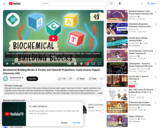
Although we've spent a lot of time in this series looking at human-made organic chemicals, the term "organic chemistry" was originally used to describe molecules isolated from living things. In this episode of Crash Course Organic Chemistry, we're going back to our roots to learn more about the best synthetic chemists: living things. We'll look at the biochemical building blocks of life from the nitrogenous bases, sugars, and phosphate groups that make up DNA and RNA, to amino acids and lipids, and we'll learn how to convert between Fischer and Haworth projections of carbohydrates.

This course focuses on the interaction of chemical engineering, biochemistry, and microbiology. Mathematical representations of microbial systems are featured among lecture topics. Kinetics of growth, death, and metabolism are also covered. Continuous fermentation, agitation, mass transfer, and scale-up in fermentation systems, and enzyme technology round out the subject material.

Word Count: 41284
Included H5P activities: 27
(Note: This resource's metadata has been created automatically by reformatting and/or combining the information that the author initially provided as part of a bulk import process.)
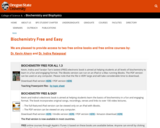
We are happy to welcome you to our second Open Educational Resource (OER) textbook, Biochemistry Free For All. Biochemistry is a relatively young science, but its rate of growth has been truly impressive. The rapid pace of discoveries, which shows no sign of slowing, is reflected in the steady increase in the size of biochemistry textbooks. Growing faster than the size of biochemistry books have been the skyrocketing costs of higher education and the even faster rising costs of college textbooks. These unfortunate realities have created a situation where the costs of going to college are beyond the means of increasing numbers of students.
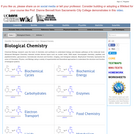
Chemical Biology research uses the tools of chemistry and synthesis to understand biology and disease pathways at the molecular level. Advanced Biological Chemistry interests include diverse topics such as nucleic acids, DNA repair, bioconjugate chemistry, peptides and peptidomimetics, glycoscience, biomolecular structure and function, imaging, and biological catalysis. Biophysical Chemistry represents the union of Chemistry, Physics, and Biology using a variety of experimental and theoretical approaches to understand the structure and function of biological systems.

This course is an advanced treatment of biochemical mechanisms that underlie biological processes. Topics include macromolecular machines such as the ribosome, the proteasome, fatty acid synthases as a paradigm for polyketide synthases and non-ribosomal polypeptide synthases, and polymerases. Emphasis will be given to the experimental methods used to unravel how these processes fit into the cellular context as well as the coordinated regulation of these processes.
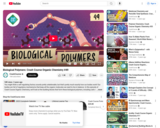
You might think a self regulating factory sounds pretty unbelievable, but that’s pretty much exactly how our bodies work! Our bodies are full of regulatory mechanisms that keep all the organic molecules we need to live in balance. In this episode of Crash Course Organic Chemistry, we’ll look at the building blocks that form these biological polymers, including carbohydrates, proteins, and DNA!
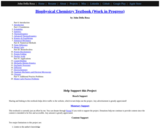
A free online textbook for biophysical chemistry. The book covers probability, statistics, thermodynamics, kinetics, Monte Carlo methods, biochemistry, diffusion, stochastic processes, and others.
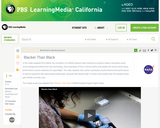
In this video adapted from NASA, two members of a NASA research team working to produce carbon nanotubes share some background behind this new technology, show examples of how it will be useful, and explain the various tests being performed to ensure readiness for spaceflight.
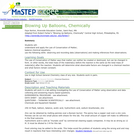
A 90 minute laboratory experiment utilizing observations and reasoning regarding the Law of Conservation of Matter and Energy.
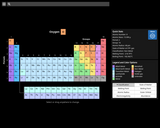
Blue Coral Periodic Table is your quick guide to all 118 elements. Swipe and tap your way across the table for quick stats on each element. Dive deeper and recolor the table with patterns based off properties such as boiling point, melting point, and atomic radius.
View the atomic model for each element and see how the electron configuration changes as you move from element to element.
Blue Coral Periodic Table is fully responsive in the web browser for large and small devices in both horizontal and vertical orientations.
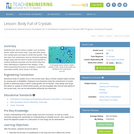
Students learn about various crystals, such as kidney stones, within the human body. They also learn about how crystals grow and ways to inhibit their growth. They also learn how researchers such as chemical engineers design drugs with the intent to inhibit crystal growth for medical treatment purposes and the factors they face when attempting to implement their designs. A day before presenting this lesson to students, conduct the associated activity, Rock Candy Your Body.
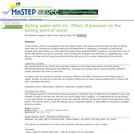
This guided inquiry activity, in which ice is used to boil water in a Florence flask, works well in the introductory class to a chemistry or physical science course. The students will learn the difference between observation and inference and apply this understanding to various other situations in which observations and inferences must be made. The students will also use outside sources to try to explain why the activity worked.
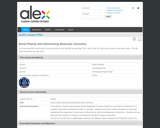
In this lesson, students will examine electronegativities of atoms relative to one another to determine if a covalent bond will be classified as polar or nonpolar. Students will use an online simulation to help them understand the importance of lone pairs of electrons as well as bonding pairs of electrons. Students will use ball-and-stick models to examine and identify the shapes of various molecules. This lesson results from a collaboration between the Alabama State Department of Education and ASTA.
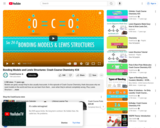
Models are great, except they're also usually inaccurate. In this episode of Crash Course Chemistry, Hank discusses why we need models in the world and how we can learn from them... even when they're almost completely wrong. Plus, Lewis Structures!
Chapters:
Models
Linus Pauling & The Bonding Model
Lewis Dot Structures
Ionic Bonds
Covalent Bonds
Double Bonds
Triple Bonds

This is a great lab to do with students during October while most grocery stores stock dry ice for Halloween! Explore sublimation in action!

This video segment, adapted from NOVA scienceNOW, presents basic concepts of physics behind booming sand dunes. See how surface tension affects potential and kinetic energy and how it all works together to create sound.
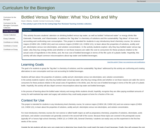
In the activity students learn about the properties of solutions, acidity and pH, electrolytes versus non-electrolytes, and solution concentration. Hopefully, this activity will also dispel common misconceptions about tap water and bottled beverages.
(Note: this resource was added to OER Commons as part of a batch upload of over 2,200 records. If you notice an issue with the quality of the metadata, please let us know by using the 'report' button and we will flag it for consideration.)

Students investigate whether a bowling ball will float or sink in an aquarium of water after measuring the ball and determining the density. This is meant to be an investigative inquiry of the concepts of density and significant figures.